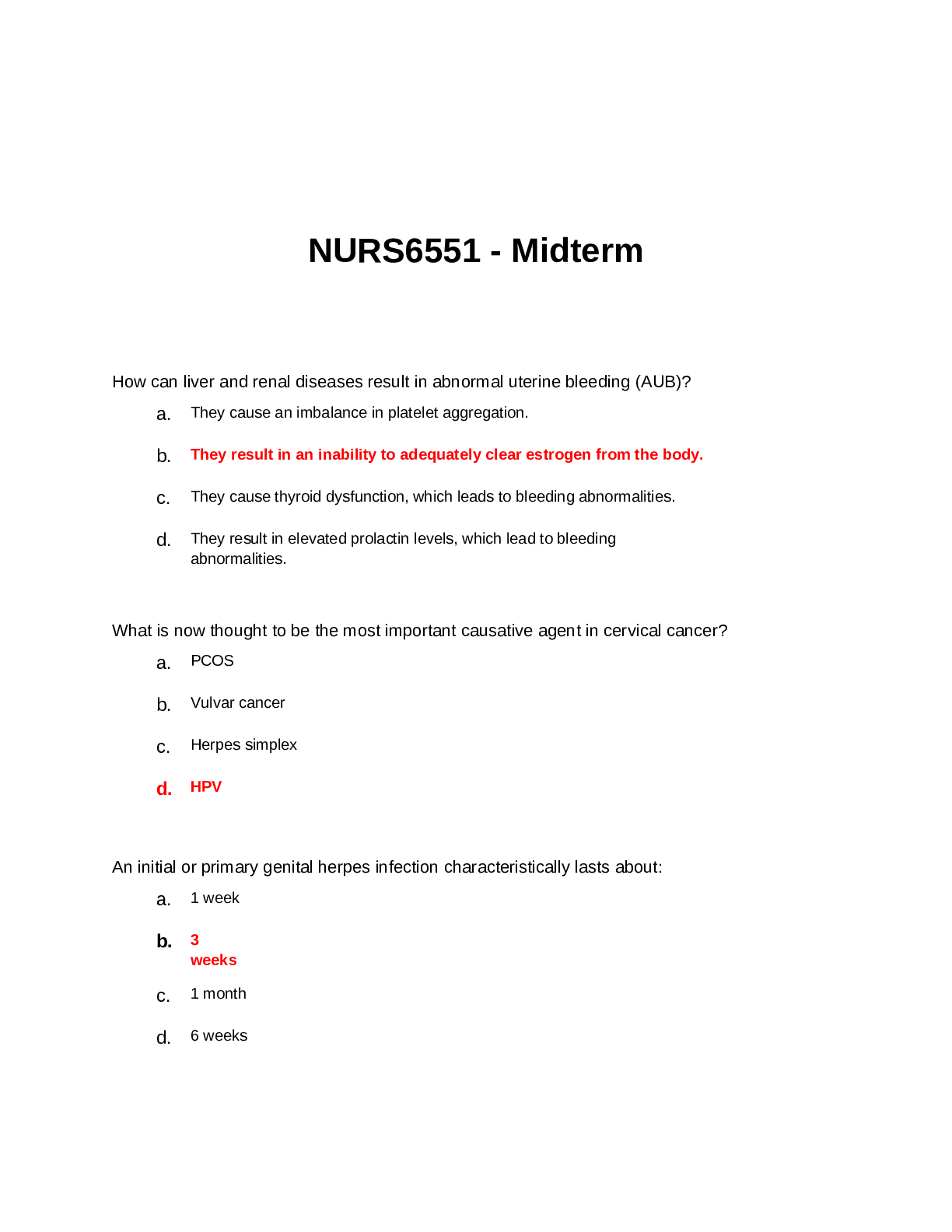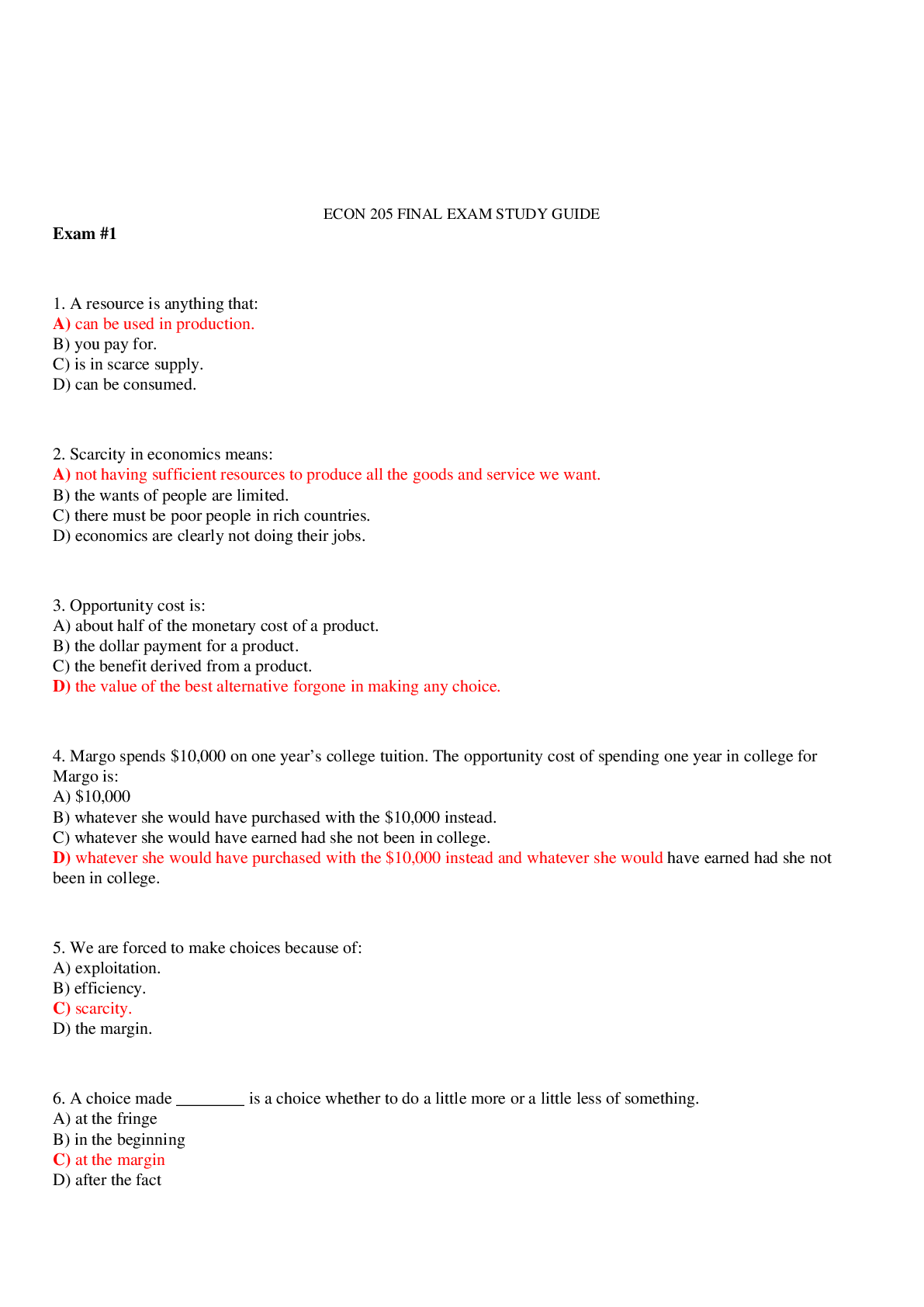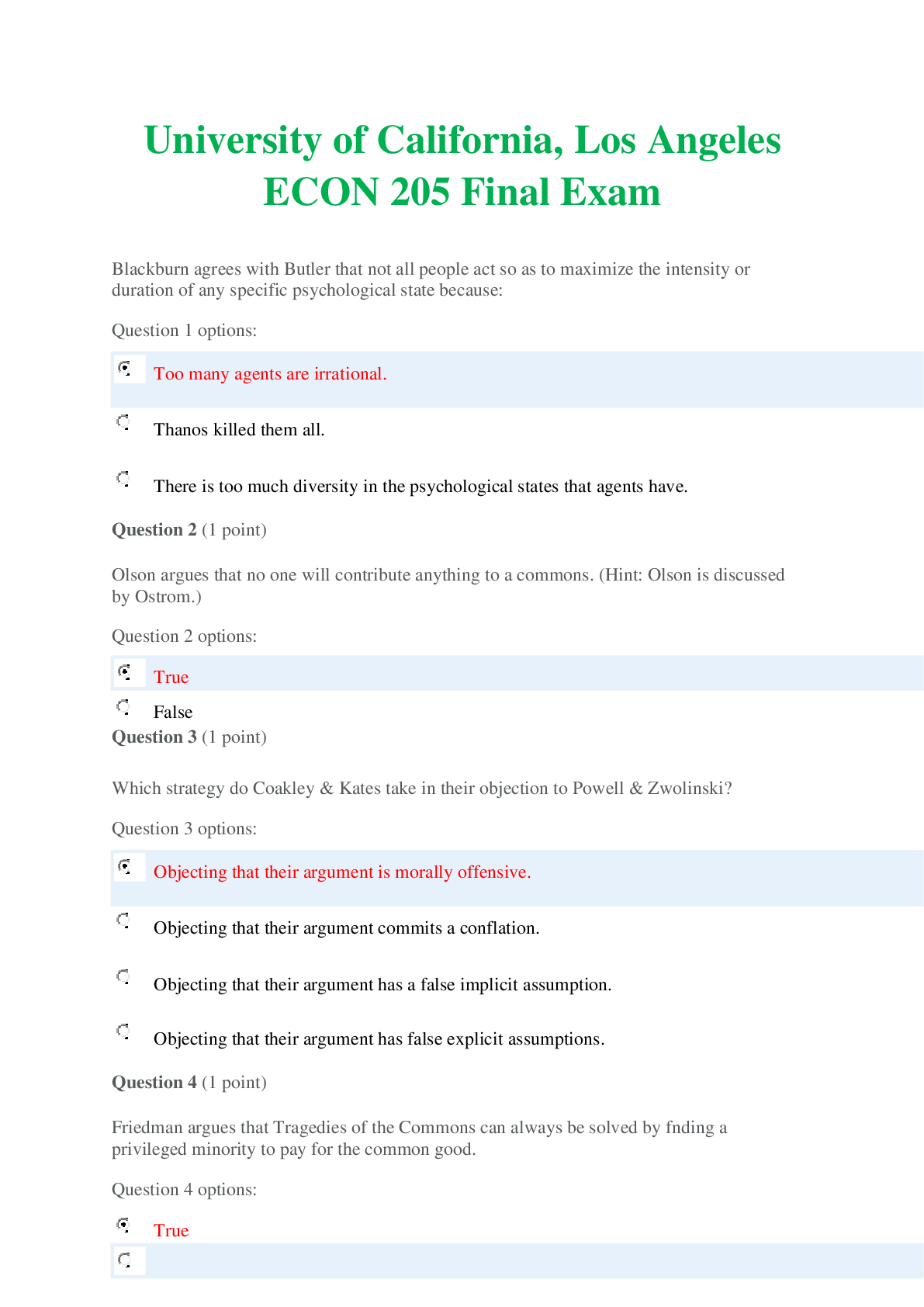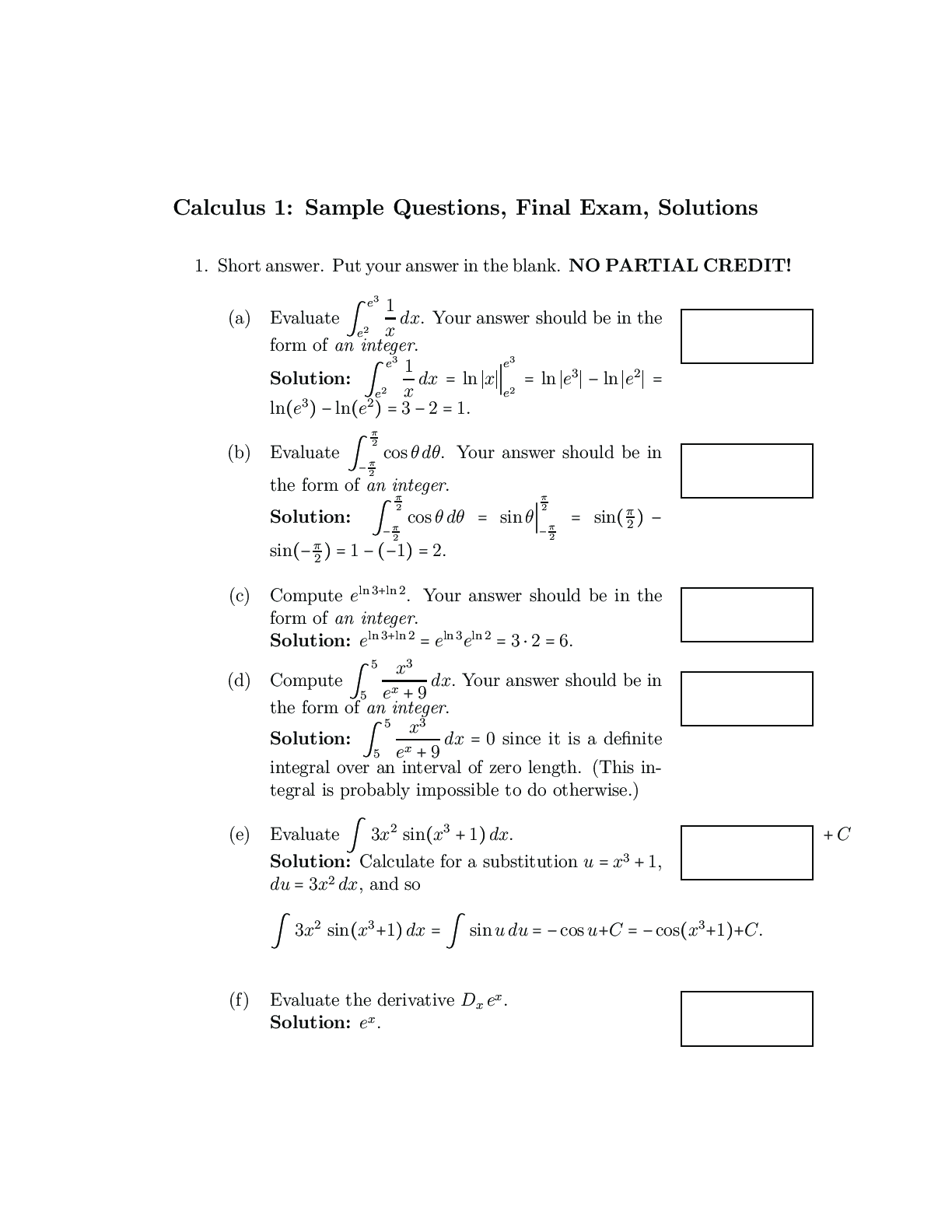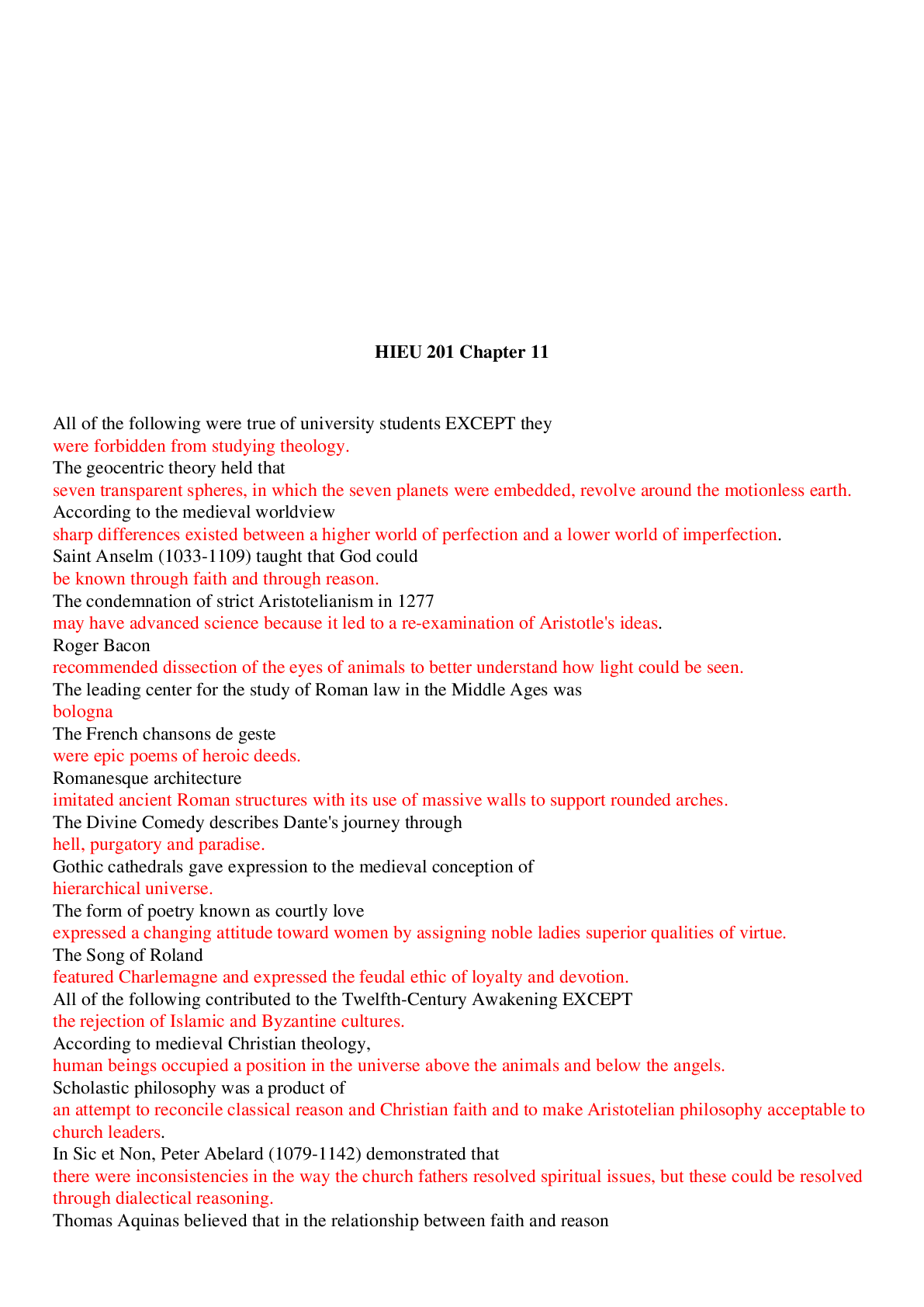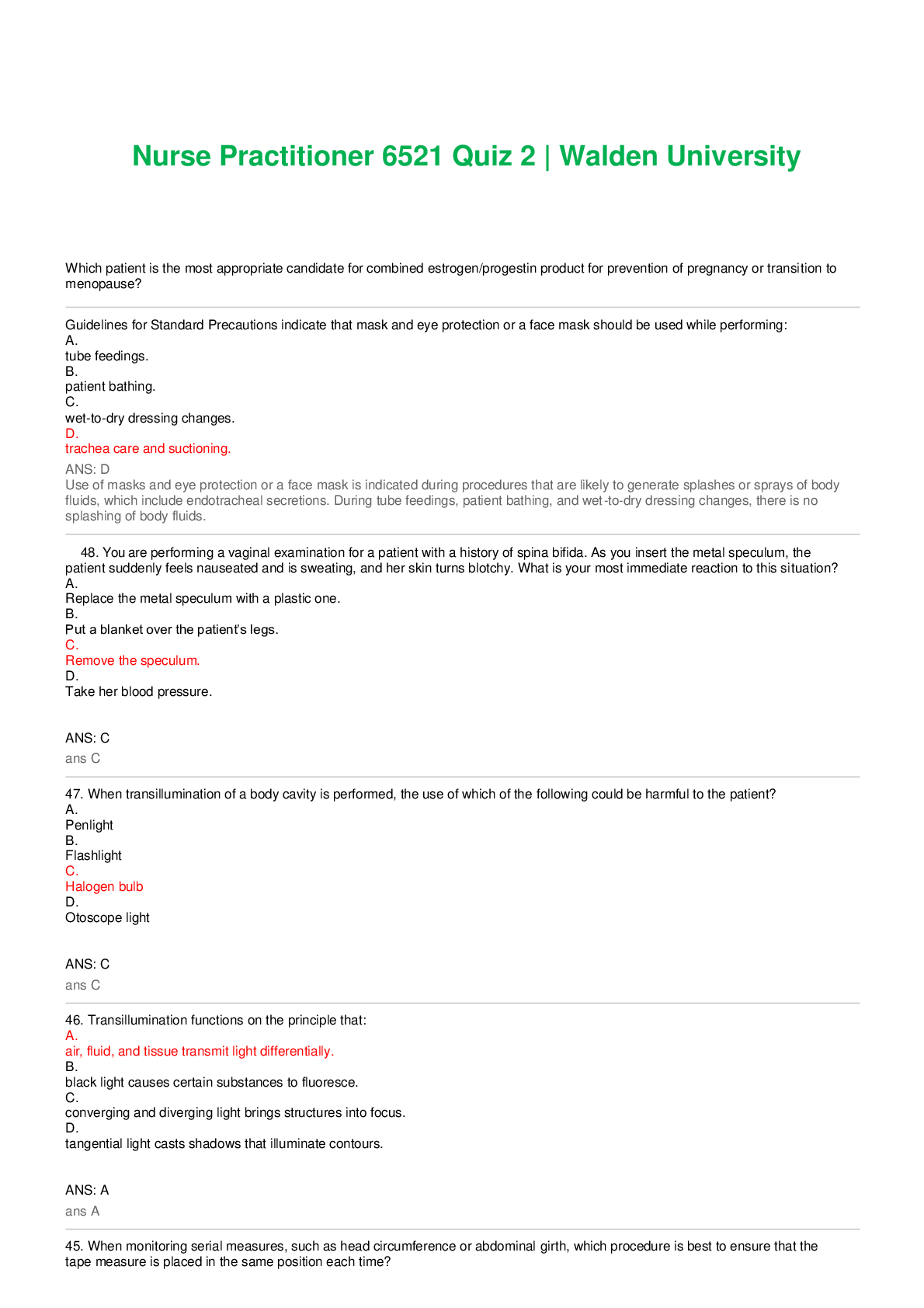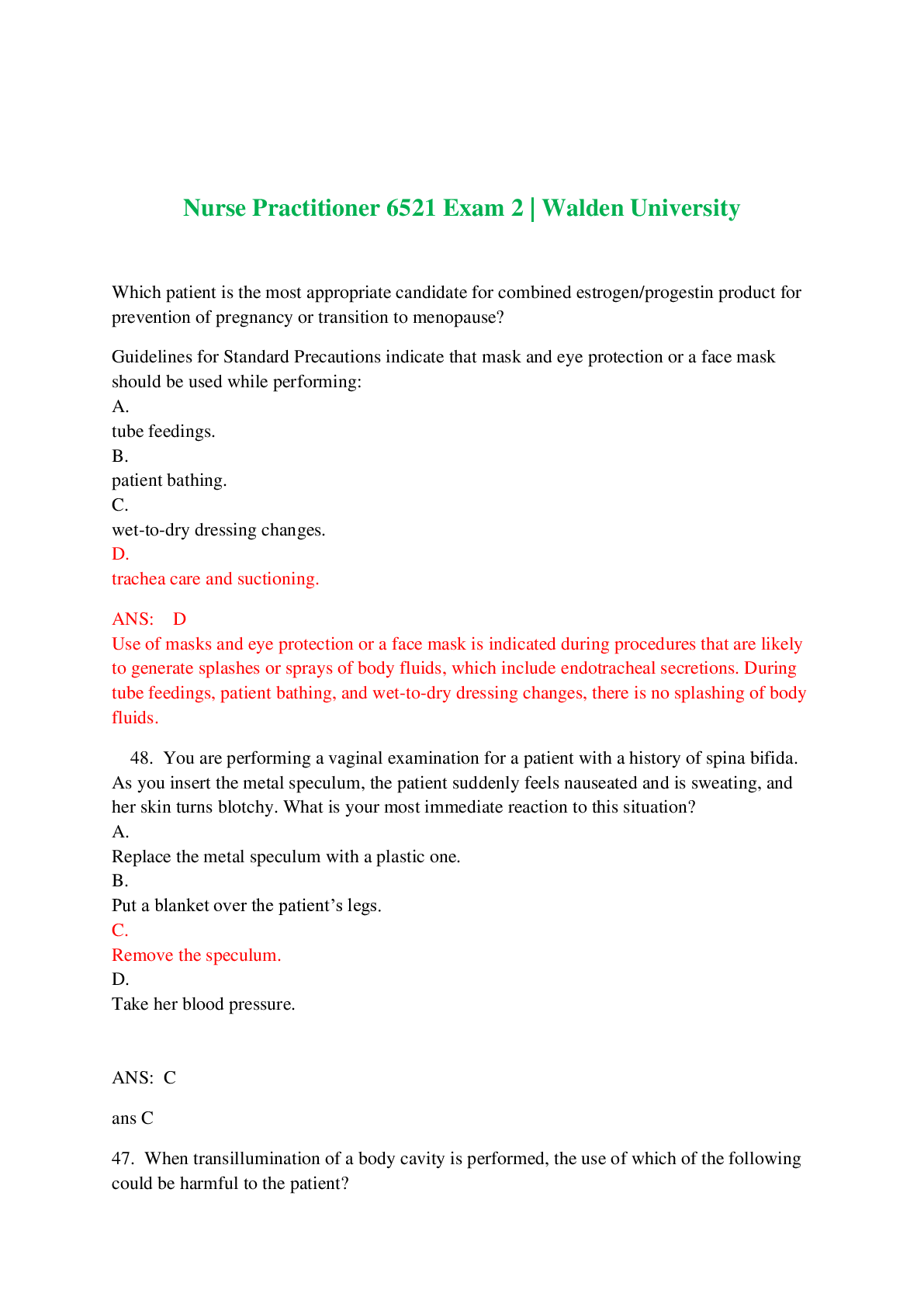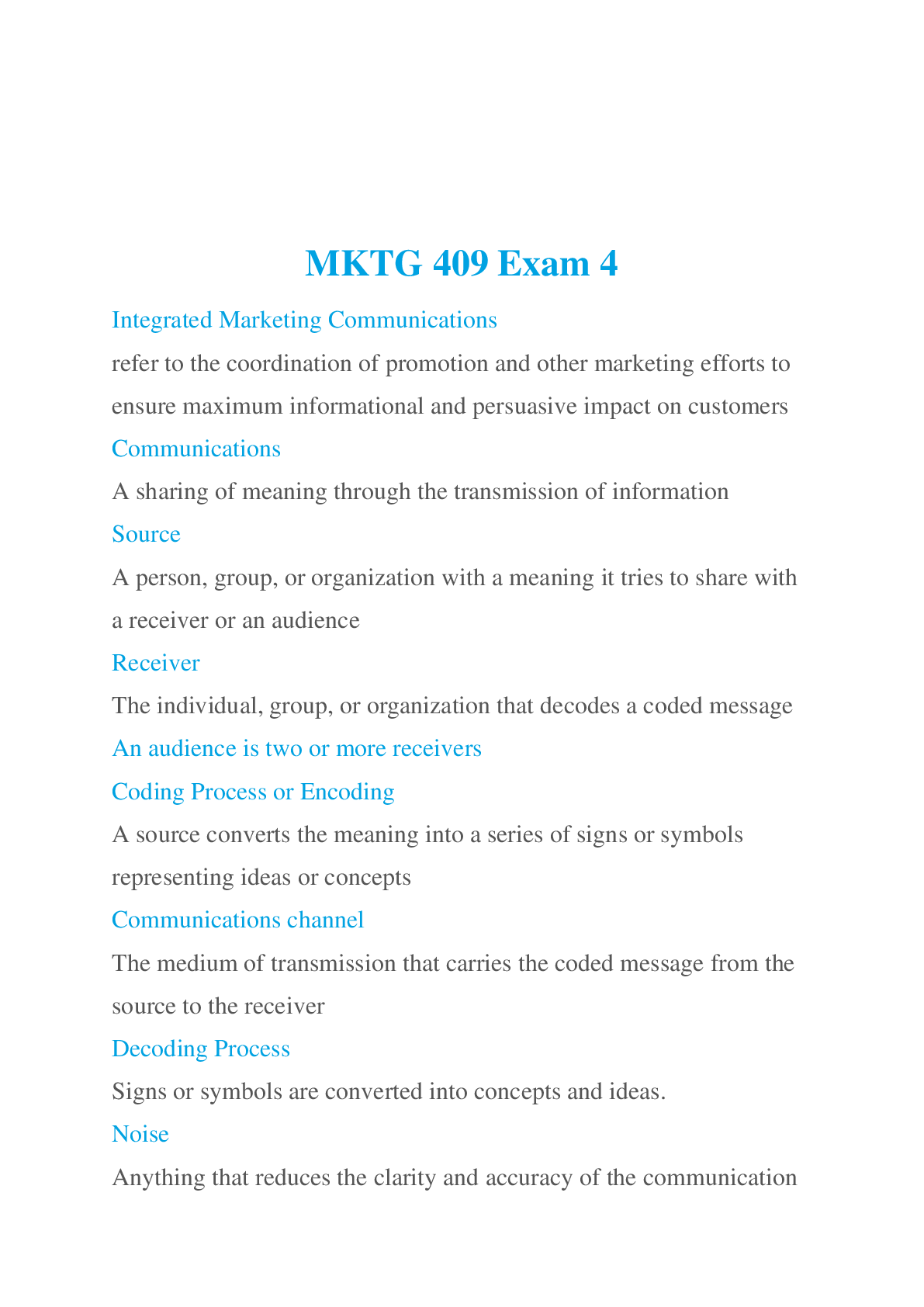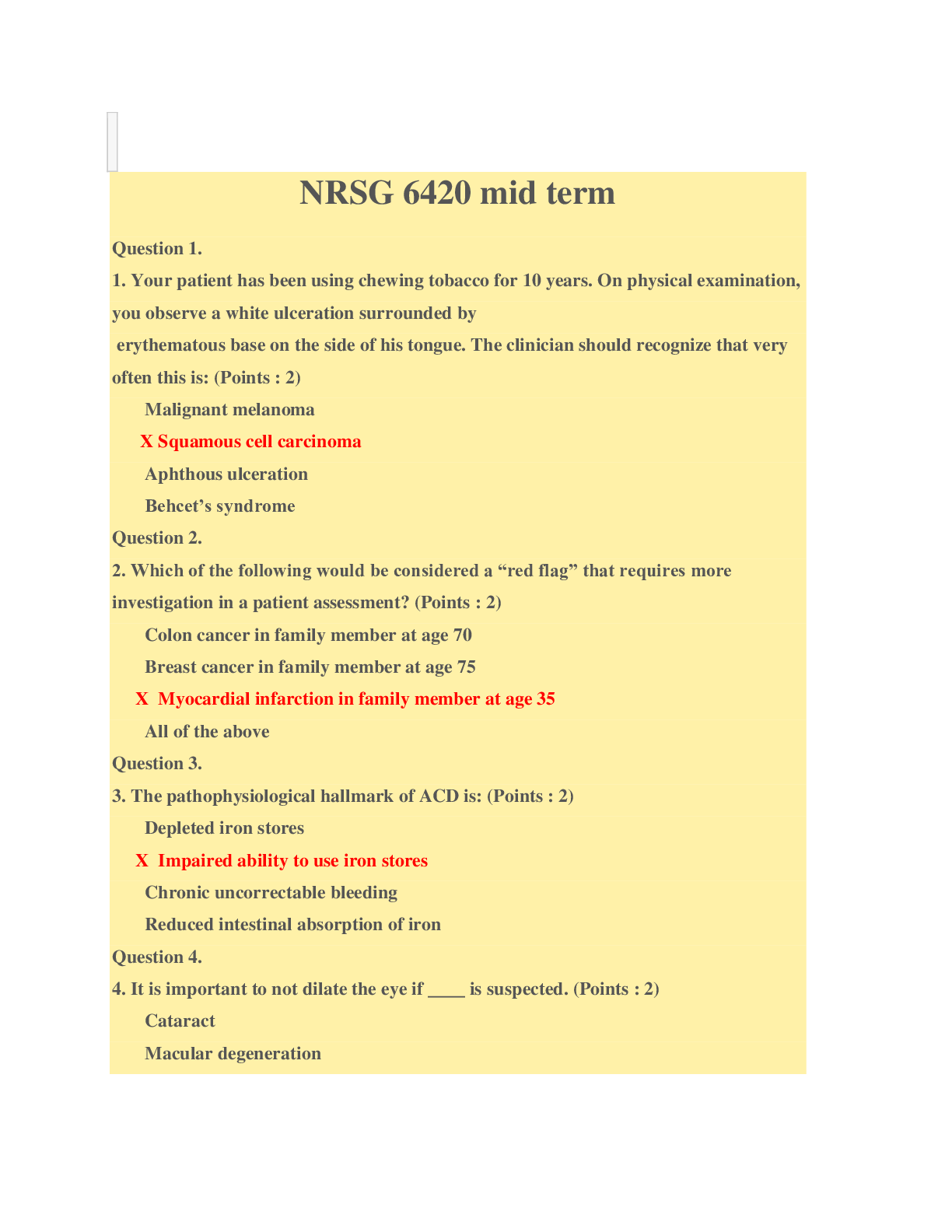The Electric Potential-solutions
Document Content and Description Below
gilvin (jg47854) - 8: The Electric Potential - meyers - (21235) 1 This print- out should have 22 questions. Multiple-choice questions may continue on the next column or page - find all choices bef... ore answering. so the magnitude of the potential difference is Δ σ V = E d = d ϵ0 This homework is due Tuesday, March 1, at ( midnight Tucson time. = 1.1 × 10−10 C/m2 ) (0.011 m) 8.85419 × 10−12 C2 /N · m2 001 10.0 points To recharge a 12 V battery, a battery charger must move 2.4 × 105 C of charge from the negative terminal to the positive terminal. How much work is done by the battery charger? Correct answer: 2.88 × 106 J. Explanation: Given : q = 2.4 × 105 C and V = 12 V . The potential difference is V = W q , W = q V = (2.4 × 105 C) (12 V) = 2.88 × 106 J . 002 10.0 points Two flat conductors are placed with their inner faces separated by 11 mm. If the surface charge density on one of the inner faces is 110 pC/m2 and the other inner face −110 pC/m2 , what is the magnitude of the electric potential difference between the two conductors? Correct answer: 0.136658 V. Explanation: Let: ϵ0 = 8.85419 × 10−12 C2 /N · m2 , σ = 110 pC/m2 = 1.1 × 10−10 C/m2 , and d = 11 mm = 0.011 m . The electric field between two flat conductors is = 0.136658 V . 003 10.0 points A voltmeter indicates that the difference in potential between two plates is 53 V. The plates are 0.36 m apart. What electric field intensity exists between them? Correct answer: 147.222 N/C. Explanation: Let : V = 53 V and d = 0.36 m . The potential difference is V = E d E = V d = 53 V 0.36 m = 147.222 N/C . 004 10.0 points Two parallel conducting plates are connected to a constant voltage source. The magnitude of the electric field between the plates is 2022 N/C. If the voltage is quadrupled and the distance between the plates is reduced to 1 5 the original distance, what is the magnitude of the new electric field? Correct answer: 40440 N/C. E = σ ϵ0 Explanation: gilvin (jg47854) - 8: The Electric Potential - meyers - (21235) 2 Q is the total Let : E = 2022 N/C , charge inside R the sphere. V ′ = 4 V , and d ′ = 1 5 d . The electric field between two parallel conducting plates is E = −V d , where V is the p Using Gauss’s Law, you can show that for ρ r voltage between the plates, and d is the distance between the plates, so the new electric field has a magnitude of ( ) r < R the electric field is given by E = , 3 ϵ0 where ρ is the charge density. The charge density ρ is E′ = −V ′ d ′ = 20 E = − 4 V = 20 −V d d 1. ρ = Q 5 π R3 . Q = 20 (2022 N/C) = 40440 N/C . 005 10.0 points When you touch a friend after walking across a rug on a dry day, you typically draw a spark of about 2 mm. 2. ρ = ϵ0 . 3. ρ = Q 2 π R . 4. ρ = Q 4 π R3 . 5. ρ = Q ϵ0 . 4 Q The magnitude of the electric field for which dielectric breakdown occurs in air is about 3 MV/m. Estimate the potential difference between you and your friend before the spark. Correct answer: 6000 V. 6. ρ = 3 π R3 . 7. ρ = Q π R2 . 8. ρ = Q 4 π R2 . Q 9. ρ = Explanation: 10. ρ = R3 . 3 Q 4 π R3 . correct Let : r = 2 mm = 0.002 m and Eb = 3 MV/m = 3 × 106 V/m . The potential difference is V = Eb r Explanation: The charge density is the charge per unit volume, so ρ = Q = 3 Q = (3 × 106 V/m) (0.002 m) = 6000 V . 006 (part 1 of 4) 10.0 points The volume of the sphere shown in the figure below is uniformly charged (with positive charge). 4 π R3 4 π R3 . 3 007 (part 2 of 4) 10.0 points Compare the potentials between the point p at the center and a point on the surface of the sphere where r = R (p is located at the center of the sphere). gilvin (jg47854) - 8: The Electric Potential - meyers - (21235) 3 ∫ R ρ r 1. Vp < V = − R 0 3 ϵ0 dr 2. Vp = V R 3. Vp > V R correct Explanation: ∫ R V R − Vp = − 0 ∫ R = − 0 Er dr ρ r 3 ϵ0 dr = −ρ R2 6 ϵ0 . 009 (part 4 of 4) 10.0 points Q is 4 µC and R is 2.1 m. What is the potential at the surface, assuming that the potential is zero at infinity? Correct answer: 17123.8 V. = R −ρ 2 6 ϵ0 . This implies that V R < Vp . 008 (part 3 of 4) 10.0 points The magnitude of the potential difference between (r = R) and p is given by ρ π R2 Explanation: Let : k = 8.99 × 109 N · m2 /C2 , Q = 4 µC = 4 × 10−6 C and R = 2.1 m . The potential on the surface of the sphere can be calculated as 1. V R − Vp = ϵ0 ∫ R ρ R2 Vs = − k Q dr = k Q 2. V R − Vp = ∞ r 2 R 3 ϵ0 . ( ρ π 4 R2 = 8.99 × 109 N · m2 /C2 ) (4 × 10−6 C) 3. V R − Vp = 3 ϵ0 ρ R2 2.1 m = 17123.8 V . 4. V R − Vp = 6 ϵ0 . correct ρ 5. V R − Vp = ϵ0 . ρ R 010 10.0 points An electric field is given by Ex = (4 kN/C) x3 . 6. V R − Vp = 3 ϵ0 . Find the potential difference between the points on the x-axis at x = 1 m and x = 5 m. 7. V R − Vp = ρ 3 ϵ0 . Correct answer: −624 kV. ρ R2 8. V R − Vp = 2 ϵ0 . ρ 4 π R2 Explanation: 9. V R − Vp = ϵ0 ρ R Let : Ex = (4 kN/C) x3 , 10. V R − Vp = Explanation: 2 ϵ0 . ∫ R x1 = 1 m , and x2 = 5 m . VR − Vp = − Er dr Ex = −d V 0 dx , so gilvin (jg47854) - 8: The Electric Potential - meyers - (21235) 4 dV = −Ex dx 8. Q2′ = Q1 − Q2 ∫ x2 V2 − V1 = − x1 Ex dx ∫ x2 9. Q2′ = Q2 − Q1 2 = (4 kN/C) − x 3 dx ( x1 ) Explanation: Basic Concepts: Gauss’ Law 1 ( = (4 kN/C) − x 2 − x1 ) 4 ( ) 1 = −(4 kN/C) 4 [ × (5 m)4 − (1 m)4 ] = −624 kV . 011 (part 1 of 3) 10.0 points Consider a solid conducting sphere with a radius a and charge Q1 on it. There is a conducting spherical shell concentric to the sphere. The shell has an inner radius b (with b > a) and outer radius c and a net charge Sketch a concentric Gaussian surface S (dashed line) within the shell. r Since the electrostatic field in a conducting medium is zero, according to Gauss’s Law, ΦS = Q1 + Q′2 = 0 Q2 on the shell. Denote the charge on the inner surface of the shell by Q′ 2 and that on the outer surface of the shell by Q2′ . Q1 , a b , Q′ 2 P Q2 Q2′ , c Q1 Find the charge Q2′ . 1. Q2′ = Q1 + Q2 correct 2. Q2′ = 2 (Q2 − Q1 ) 3. Q2′ = 2 (Q1 + Q2 ) 4. Q2′ = Q2 − Q1 ϵ0 Q′ 2 = −Q1 But the net charge on the shell is Q2 = Q′ 2 + Q2′ , so the charge on the outer surface of the shell is Q2′ = Q2 − Q′ 2 = Q2 + Q1 . 012 (part 2 of 3) 10.0 points Find the (magnitude )f the electric field at point P ∥ E P ≡ E ∥ P , where the distance from P to the center is r = a + b 2 1. E P = 2 ke (aQ1 b)2Q2 ) + 5. Q2′ = Q1 + Q2 2. EP = 2 ke (aQ1 b)2Q2 ) 2 + 6. Q2′ = 2 (Q1 − Q2 ) 7. Q2′ = Q1 − Q2 3. E P = 4 ke Q2 (a + b)2 2 4. EP = 4 ke (aQ1 b)2Q2 ) + P = 2ak e Q1 + b + k e Q2 P = 2 k e (Q1 ? Q2 ) P = ae Q1 + b ? k e Q2 P = 2ak e Q1 P = 2ak e Q1 + b ? 2 k e Q2 P = 2ak e Q1 + b + k e Q1 P = 2ak e Q1 + b ? k e Q1 P = 2ak e Q1 + b ? k e Q2 a + b ? k e Q1 gilvin (jg47854) - 8: The Electric Potential - meyers - (21235) 5 4 ke Q1 5. EP = (a + b)2 correct 6. E P = 4 ke (aQ1 b)2Q2 ) + 7. E P = 0 2 ke Q1 9. V c Explanation: Using the superposition principle, adding the 3 concentric charge distributions; i.e., Q1 at a, −Q1 at b and Q1 + Q2 at c, gives ∫ E r 8. E P = 9. E P = (a + b)2 2 ke Q2 (a + b)2 VP = − · dr , by symmetry, ⃗ ∫ = − Er dr Explanation: Choose as your Gaussian surface concentric with the spherical surface S, which passes ∫ c ∫ b ∫ (a+b)/2 = − Er dr − 0 dr − Er dr ∫ ∞ c b c k (Q1 + Q2 ) through P . Here, ∫ E · A = 4 r π 2 E = Q1 ϵ0 P = − dr ∞ r 2 ∫ b ∫ (a+b)/2 − 0 dr − c b ( 1 ) i c = −k (Q1 + Q2 ) i k (Q1 + Q2 ) dr r 2 r E P = 4 πQ1 i ∞ ( ) ϵ0 r2 = ke Q1 r 2 = 4 ke Q1 = 2 ke Q1 1 i (a+b)/2 −0 − k (Q1 + Q2 ) v r b + ke (Q1 + Q2 ) (a + b)2 . 013 (part 3 of 3) 10.0 points Assume: The potential at r = ∞ is zero. Find the potential V P at point P . 1. V b c 014 (part 1 of 5) 10.0 points Consider two “solid” conducting spheres with radii r1 = 2 R and r2 = 5 R ; i.e., r 2 r 1 = 2 R = 2 . c The two spheres are separated by a large 2. V 3. V 4. V 5. V 6. V P = 0 7. V 8. V a + b b + b b b − ke (Q1 − Q2 ) c + ke (Q1 + Q2 ) cordistance so that the field and the potential at the surface of sphere #1 only depends on the charge on #1 and the corresponding quantities on #2 only depend on the charge on #2. Place an equal amount of charge on both spheres, q1 = q2 = Q . r 2 r 1 #1 q1 q2 rect b c gilvin (jg47854) - 8: The Electric Potential - meyers - (21235) 6 After the electrostatic equilibrium on each = r1 sphere has been established, what is the ratio r 2 of the potentials V2 at the “centers” of the = 2 R V1 two solid conducting spheres? 1. V2 V1 = 2 2. V2 V1 = 5 correct 3. V2 V1 = 1 4. V2 V1 = 4 5. V2 V1 = 245 6. V2 V1 = 258 7. V2 V1 = 254 8. V2 V1 = 252 9. V2 V1 = 5 Explanation: For a solid conducting sphere, the charge is uniformly distributed at the surface. From Gauss’ Law, the electric field outside the sphere is given by E(r) = k Q r 2 , where Q is the total charge on the sphere and r is the distance from the center of the sphere. By in5 R = 2 5 . 015 (part 2 of 5) 10.0 points What is the ratio of the electric fields the “surfaces” of the two spheres? 1. E2 E1 = 2 2. E2 E1 = 1 3. E2 E1 = 252 4. E2 E1 = 258 5. E2 E1 = 245 correct 6. E2 E1 = 5 7. E2 E1 = 4 8. E2 E1 = 254 9. E2 E1 = 5 Explanation: E2 E1 at tegration with respect to r, the potential can be expressed as V (r) = k Q r , so the potential at the surface of the sphere is V (r) = k Q (1) For a conducting sphere, the charge is uniformly distributed at the surface. Based on Gauss’ law, the electric field on the surface of a conducting sphere of radius R with charge Q is r , where R is radius of the sphere and r R . ≤ For the electrostatic case, the potential is constant throughout a conducting body, so the potential at the center is the same as anywhere on the conductor. Thus at two centers k q2 E(r) = ke Q (2) r 2 , where r ≥ R . Thus on the surface r = R of the two spheres, k q2 V2 V1 = r 2 k q1 r 1 E2 E1 = r 2 k q2 r 1 gilvin (jg47854) - 8: The Electric Potential - meyers - (21235) 7 ( ) 2 = ( = r 1 r 2 2 R 5 R charge will flow from one to the other until the potential on both spheres is the same. ) 2 As noted, V2 V1 = 1 , defines equilibrium. The spheres are connected by a wire and no ( ) 2 2 = 5 = 4 25 . current is flowing (at equilibrium), therefore the ends of the wire are at the same potential V2 = V1 . (3) 017 (part 4 of 5) 10.0 points E2 016 (part 3 of 5) 10.0 points Now “connect” the two spheres with a wire. r 2 r 1 #1 q1 q2 #2 There will be a flow of charge through the wire until equilibrium is established. V2 Now, what is the ratio of the electric fields E1 at the “surfaces” of the two spheres? 1. E2 E1 = 2 2. E2 E1 = 4 3. E2 E1 = 254 4. E2 E1 = 252 5. E2 What is the ratio of the potentials the “centers” of the two spheres? 1. V2 V1 = 2 2. V2 V1 = 254 3. V2 V1 = 4 4. V2 V1 = 252 5. V2 V1 = 245 6. V2 V1 = 1 correct 7. V2 V1 = 5 8. V2 V1 = 258 9. V2 V1 at E1 = 5 6. E2 E1 = 5 correct 7. E2 E1 = 258 8. E2 E1 = 1 9. E2 E1 = 245 Explanation: For a conducting sphere, the charge is uniformly distributed at the surface. Based on Gauss’ law, on the surface of a conducting sphere of radius R with charge Q is E(r) = ke Q r 2 , where r ≥ R , and V (r) = k Q r , where r ≤ R . Thus on the surface r = R of the two spheres, k q2 V1 = 5 Explanation: When the spheres are connected by a wire, E2 r 2 E1 = k q2 r 1 (4) gilvin (jg47854) - 8: The Electric Potential - meyers - (21235) 8 1 = k q2 r 2 k q1 r 1 1 = 5 (5) r 2 2 q1 . 1 r 1 The total charge of the system remains constant; i.e., from the initial condition q1 = V2 = V1 = r1 r 2 = 2 R 5 R = 2 r 2 1 , since V1 = V2 r 1 q2 = Q, the total change on both spheres is q1 + q2 = 2 Q. Using q2 from Eq. 5, we have q1 + q2 = 2 Q q1 + 5 2 q1 = 2 Q 7 2 q1 = 2 Q 4 5 . q1 = 018 (part 5 of 5) 10.0 points 7 Q . Now, what is the charge q1 on sphere #1? And the charge on sphere # 2 is q2 = 10 7 Q , 1. q1 = 5 7 Q 2. q1 = 7 2 Q 7 since q1 + q2 = 4 7 Q + 107 Q = 2 Q . Check Eq. 4: On the surfaces of the two spheres, ( ) ( ) 2 3. q1 = 10 Q E2 E1 = q2 q1 r 1 r 2 4. q1 = 2 7 Q 5. q1 = 7 4 Q = i i i ( i 10 Q ( ) 2 7 i 2 R i 4 5 R 7 Q ) ( ) 2 6. q1 = 7 5 Q 7. q1 = 10 7 Q 8. q1 = Q 9. q1 = 4 7 Q correct Explanation: When the spheres are connected by a wire, charge will flow from one to the other until the potential on both spheres is the same. In this case, this implies that ke q1 r 1 = ke r2 , or q2 = r2 r1 q1 = 5 R 2 R q1 5 2 = 2 5 = 2 5 . Fourth of eighteen versions. 019 10.0 points The uniformly charged sphere gives a reasonable model of the proton charge distribution in an atomic nucleus. A nucleus of lead-208 has a radius of 2.669×10−15 m and contains 82 protons, each with a charge of 1.6 × 10−19 C. Calculate the electric potential at the surface of this nucleus. Correct answer: 4.41801 × 107 V. Explanation: 8.99 * 109 N E m2 /C2 E 109 nC gilvin (jg47854) - 8: The Electric Potential - meyers - (21235) 9 021 (part 1 of 2) 10.0 points Let : r = 2.669 × 10−15 m , e = 1.6 × 10−19 C , Z = 82 , and ke = 8.98755 × 109 N · m2 /C2 . The potential is ∫ A uniformly charged sphere has a potential on its surface of 430 V. At a radial distance of 20 cm from this surface, the potential is 120 V. The Coulomb constant is 8.99 × 109 N · m2 /C2 . What is the radius of the sphere? V = k e dq r Correct answer: 0.0774194 m. Gauss’s law tells us that the expression for the electric field outside of a sphere (charge Q) is the same as that of a point charge located at the center of the sphere with the same charge Q. Thus we can calculate the electric potential at the surface of the sphere by assuming all the charge is concentrated at the center: Explanation: Let : Vs = 430 V , Vd = 120 V , and d = 20 cm = 0.2 m . V ∝ 1 is V = k e Qtot r R , so the ratio of the potentials Vs + d = k e Z e r = 8.98755 × 109 N · m2 /C2 ( Vd = R R Vs R = Vd (R + d) R = Vd d × 82 1.6 × 10−19 C) Vs − Vd 2.669 × 10−15 m = 4.41801 × 107 V . 020 10.0 points A 13 V battery is connected across two parallel metal plates separated by 0.26 cm. Find the magnitude of the electric field. Correct answer: 5000 V/m. Explanation: Let : ΔV = 13 V and Δd = 0.26 cm . ΔV = −E Δd = (120 V) (0.2 m) 430 V − 120 V = 0.0774194 m . 022 (part 2 of 2) 10.0 points What is the charge of the sphere? Correct answer: 3.70304 nC. Explanation: Let : k = 8.99 × 109 N · m2 /C2 . The potential on surface is Vs = k Q R Q = Vs R k = (430 V) (0.0774194 m) |E | = VΔ Δd 13 V = 3.70304 nC . 1 C = 0.0026 m = 5000 V/m . keywords: [Show More]
Last updated: 2 years ago
Preview 1 out of 11 pages
.png)
Buy this document to get the full access instantly
Instant Download Access after purchase
Buy NowInstant download
We Accept:

Reviews( 0 )
$7.50
Can't find what you want? Try our AI powered Search
Document information
Connected school, study & course
About the document
Uploaded On
May 05, 2021
Number of pages
11
Written in
Additional information
This document has been written for:
Uploaded
May 05, 2021
Downloads
0
Views
52



 (2).png)


.png)



 (1).png)
